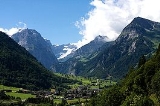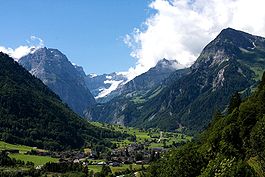
Linthal
Encyclopedia
Linthal is a former municipality
in the canton
of Glarus in Switzerland
. Effective from 1 January 2011, Linthal is part of the municipality of Glarus Süd
.
 Linthal has an area, , of 131.2 km² (50.7 sq mi). Of this area, 16.9% is used for agricultural purposes, while 15.5% is forested. Of the rest of the land, 0.9% is settled (buildings or roads) and the remainder (66.8%) is non-productive (rivers, glaciers or mountains).
Linthal has an area, , of 131.2 km² (50.7 sq mi). Of this area, 16.9% is used for agricultural purposes, while 15.5% is forested. Of the rest of the land, 0.9% is settled (buildings or roads) and the remainder (66.8%) is non-productive (rivers, glaciers or mountains).
Linthal is located in the upper end of the Grosstal where it enters the Klausen Pass
. It is the largest municipality in the Canton of Glarus, and is about 1/5 of the total area in the Canton. The highest point is the summit of the Tödi
which is 3614 m (11,857 ft) above sea level. It consists of the village of Linthal, with the three village sections of Matt, Dorf and Ennetlinth, and the scattered hamlet
of Auen.
 Linthal has a population (as of ) of . , 11.0% of the population was made up of foreign nationals. Over the last 10 years the population has decreased at a rate of -21.6%. Most of the population speaks German (84.2%), with Italian being second most common ( 4.0%) and Serbo-Croatian being third ( 2.8%).
Linthal has a population (as of ) of . , 11.0% of the population was made up of foreign nationals. Over the last 10 years the population has decreased at a rate of -21.6%. Most of the population speaks German (84.2%), with Italian being second most common ( 4.0%) and Serbo-Croatian being third ( 2.8%).
In the 2007 federal election
the most popular party was the SPS
which received 48.7% of the vote. Most of the rest of the votes went to the SVP
with 41.7% of the vote.
The entire Swiss population is generally well educated. In Linthal about 52% of the population (between age 25-64) have completed either non-mandatory upper secondary education or additional higher education (either University or a Fachhochschule
).
Linthal has an unemployment rate of 2.22%. , there were 64 people employed in the primary economic sector and about 26 businesses involved in this sector. 128 people are employed in the secondary sector and there are 13 businesses in this sector. 177 people are employed in the tertiary sector, with 41 businesses in this sector.
The historical population is given in the following table:
Municipalities of Switzerland
Communes , also known as municipalities, are the smallest government division in Switzerland, numbering 2,596 . While many have a population of a few hundred citizens, the largest cities such as Zürich or Geneva also have the legal status of municipalities...
in the canton
Cantons of Switzerland
The 26 cantons of Switzerland are the member states of the federal state of Switzerland. Each canton was a fully sovereign state with its own borders, army and currency from the Treaty of Westphalia until the establishment of the Swiss federal state in 1848...
of Glarus in Switzerland
Switzerland
Switzerland name of one of the Swiss cantons. ; ; ; or ), in its full name the Swiss Confederation , is a federal republic consisting of 26 cantons, with Bern as the seat of the federal authorities. The country is situated in Western Europe,Or Central Europe depending on the definition....
. Effective from 1 January 2011, Linthal is part of the municipality of Glarus Süd
Glarus Süd
Glarus Süd is one of three municipalities of the canton of Glarus, Switzerland .Effective from 1 January 2011, Glarus Süd incorporates the former municipalities of Betschwanden, Braunwald, Elm, Engi, Haslen, Linthal, Luchsingen, Matt, Mitlödi, Rüti, Schwanden, Schwändi and Sool.With an area of ,...
.
Geography

Linthal is located in the upper end of the Grosstal where it enters the Klausen Pass
Klausen Pass
Klausen Pass is a high mountain pass in the Swiss Alps connecting the cantons of Uri and Glarus. The pass road from Altdorf leads through the Schächen Valley, the pass and Urnerboden to Linthal in Glarus....
. It is the largest municipality in the Canton of Glarus, and is about 1/5 of the total area in the Canton. The highest point is the summit of the Tödi
Tödi
The Tödi , or Piz Russein, is the highest mountain in the Glarus Alps and the highest summit in the Canton of Glarus, Switzerland. It is located on the border between the cantons of Graubünden and Glarus...
which is 3614 m (11,857 ft) above sea level. It consists of the village of Linthal, with the three village sections of Matt, Dorf and Ennetlinth, and the scattered hamlet
Hamlet (place)
A hamlet is usually a rural settlement which is too small to be considered a village, though sometimes the word is used for a different sort of community. Historically, when a hamlet became large enough to justify building a church, it was then classified as a village...
of Auen.
Demographics

In the 2007 federal election
Swiss federal election, 2007
Elections to the Swiss Federal Assembly, the federal parliament of Switzerland, were held on Sunday, 21 October 2007. In a few cantons, a second round of the elections to the Council of States was held on 11 November, 18 November, and 25 November 2007...
the most popular party was the SPS
Social Democratic Party of Switzerland
The Social Democratic Party of Switzerland is the largest centre-left political party in Switzerland....
which received 48.7% of the vote. Most of the rest of the votes went to the SVP
Swiss People's Party
The Swiss People's Party , also known as the Democratic Union of the Centre , is a conservative political party in Switzerland. Chaired by Toni Brunner, but spearheaded by Christoph Blocher, the party is the largest party in the Federal Assembly, with 58 members of the National Council and 6 of...
with 41.7% of the vote.
The entire Swiss population is generally well educated. In Linthal about 52% of the population (between age 25-64) have completed either non-mandatory upper secondary education or additional higher education (either University or a Fachhochschule
Fachhochschule
A Fachhochschule or University of Applied Sciences is a German type of tertiary education institution, sometimes specialized in certain topical areas . Fachhochschulen were founded in Germany and later adopted by Austria, Liechtenstein, Switzerland and Greece...
).
Linthal has an unemployment rate of 2.22%. , there were 64 people employed in the primary economic sector and about 26 businesses involved in this sector. 128 people are employed in the secondary sector and there are 13 businesses in this sector. 177 people are employed in the tertiary sector, with 41 businesses in this sector.
The historical population is given in the following table:
| year | population |
|---|---|
| 1777 | 994 |
| 1799 | 1,538 |
| 1850 | 1,745 |
| 1880 | 2,301 |
| 1900 | 1,894 |
| 1950 | 1,741 |
| 1960 | 2,645 |
| 1970 | 1,458 |
| 2000 | 1,200 |

